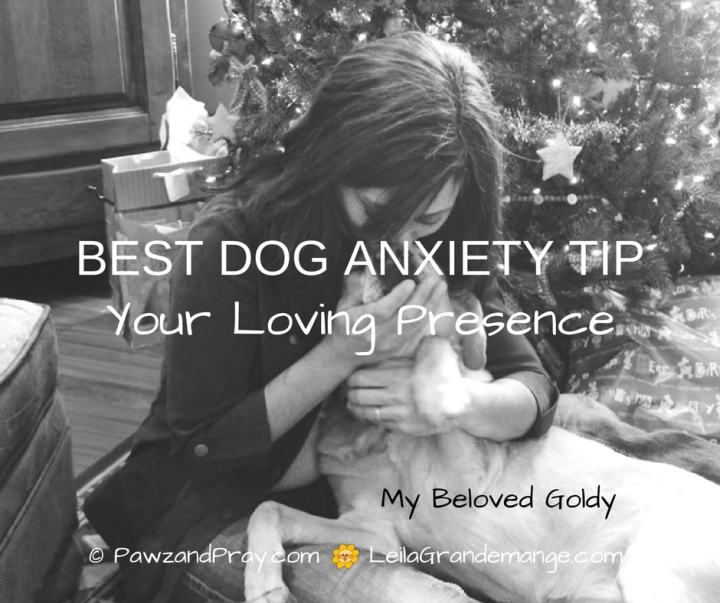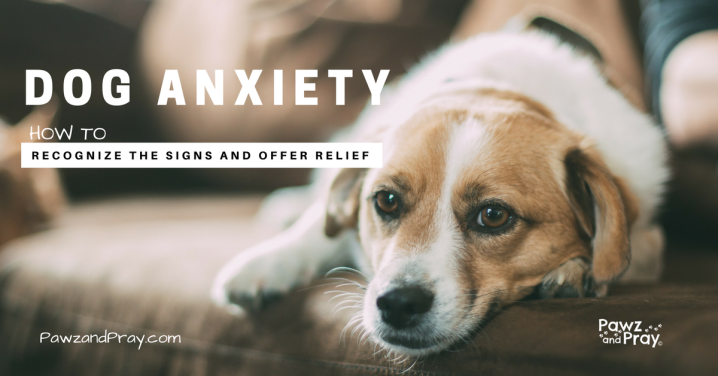NO DOG SHOULD HAVE TO SUFFER IN SILENCE
Dog anxiety, like the human anxiety, can be a debilitating and often painful experience.
If you’ve ever felt worried, uneasy, or nervous about an upcoming event or something with an uncertain outcome, or had a panic attack, you know exactly what I’m talking about! Sadly, many dogs suffer in silence because the owners are simply unaware of the signs. Having experienced a season of anxiety myself, I can’t imagine leaving a dog in an anxious state without offering help. Thankfully, there are things we can do to help our furry friends in their times of need.
The purpose of this article is to help you to recognize the signs of dog anxiety and learn how to offer relief.
INTRODUCTION
All dogs will experience anxiety to different degrees at some point, whether it’s leaving their litter mates to go to their new home, visiting the vet for the first time, or experiencing loneliness or illness.
When under stress, a dog’s system will go into “fight or flight mode”—its endocrine system releases adrenaline which causes changes like increased heartbeat, high blood pressure, rapid breathing, and dilated pupils. If left untreated, the effects of stress can lower your dog’s immune system and consequently open the door to illness. Dogs are not equally equipped to handle stress. Genetics, socialization, training, and overall well-being all play a role.
Fortunately for humans, we can verbalize our emotions to family, friends, and even to God, and receive much-needed comfort during difficult times. For our dogs, it’s not as easy. A dog’s body language usually reveals his frame of mind; but to the untrained eye, these subtle cries for help often go unnoticed until one day their owners wake up to more serious problems.
Let’s begin by learning how to recognize the signs of dog anxiety.
RECOGNIZE THE SIGNS
These signs reveal a dog’s mental state and act as little red traffic light asking you to STOP, LOOK, and OBSERVE carefully before going about your day.

Dogs don’t hide their feelings well. They’re an open book—just turn the pages, take the time, and read.
Important: Dogs showing signs of anxiety might display aggressive behavior in certain situations. Keep in mind that these signs could also indicate other health issues. Consult a vet if needed.
Now that you recognize the signs of dog anxiety, you may be wondering how you can offer your dog relief.
SUGGESTIONS TO OFFER RELIEF
1. Begin by observing your dog when he appears anxious.
What’s happening around your dog when he’s anxious? Are there loud noises nearby? Are family members arguing? Are you feeling worried or stressed (dog’s pick up on our emotions)? Is a storm approaching?
If it’s an obvious problem, place distance between your dog and the stress factor. For example, if your dog appears to stress in large crowds, calmly remove him from that situation and place him in a quiet place where he feels safe. Once you have an idea about what’s making your dog anxious, you can better prepare for or avoid similar situations which might arise in the future. This brings me to my next point . . .
2. Prepare for stressful situations or avoid them altogether.
Think ahead about what “might” stress your puppy and avoid those situations in which you cannot be sure your puppy will feel safe. Later on, you can carefully and intentionally introduce your pup to new and possibly stressful situations in a more controlled environment in order to ensure a positive experience and help him overcome his fears (desensitization). Unfortunately not all stressful situations can be avoided. But thinking ahead and preparing can alleviate a lot of anxiety for your dog.
Here’s a story to illustrate my point …
During a recent move, we drove a camper across the United States from East to West coast with our dogs. Before leaving, I thought of ways I could minimize their stress. I planned that I would sleep in the camper with our dogs, and try to keep them on a familiar routine—feeding and playtime, evening grooming and cuddles before bedtime all remained. Bringing along their favorite play things, lots of chew toys and soft comfy beds also helped. I still remember my kids lying in X-pens while the dogs piled on top of them competing for cuddles. Together, we did our best to be a calm, comforting presence for our dogs in the midst of the chaos! In return, they offered us their constant comforting companionship which relieved our stress as well.
Another stressor that can’t always be avoided is a thunder-storm. Thankfully there are ways to prepare for storms and comfort your dog. For example, my Labrador used to get extremely anxious during a storm. When I knew a storm was approaching, I’d make sure at least one family member was planning to be home. If no one was planning to be home, I’d crate her for her own protection and leave on soothing music. Calming herbs helped, as well as her “Thundershirt.” The ThunderShirt is a jacket the dog wears which applies a gentle and constant pressure which apparently has a dramatic calming effect on the nervous system of a dog. It might be worth a try if your dog is afraid of storms.
After observing your dog, knowing what stresses him, and preparing to help him, you may need some ideas to work with to see what helps your dog.
3. Try various calming methods to see what works best for your dog. Here are some suggestions.
-
A brisk walk or jog is a wonderful way to work off your dog’s anxiety! Most dogs enjoy this.

-
An older or sick dog might respond better to massage therapy than exercise.
-
Along with massage, most dogs respond well to chewing their stress away. There’s a large selection of chew toys at pet stores, bones, and “food puzzles” — toys a dog must move around to make the food come out. The Kong Toy is a great example of an entertaining toy that could ease your dogs stress.

If you’d like more ideas on how to manage your dog’s anxiety, check out some of these topics:
-
Mental and Physical Stimulation
-
Music Therapy
-
Massage Therapy
-
Desensitization
-
Exercise
-
Pheromone Therapy
-
Oils, Herbs, and Supplements
-
Recommended reading:
-
7 Ways to Calm Your Pet Naturally [Slide Show]
-
Options to prevent your dog from being alone too long— find a pet sitter or dog walker, enroll our dog in a doggie day care, come home for lunch if possible, or take your dog to work if it’s allowed.
WORDS OF ENCOURAGEMENT
If you’ve tried and tried and still not found an effective solution for your dog’s anxiety, please don’t worry or give up hope. Even for people it can take years to overcome certain fears and learn to manage stress. Sometimes, accepting “the way things are”and adapting offers a measure of peace for all. It’s not “giving up.” For me, it’s more about “letting go,” admitting that some things are out of my control, and trusting God to do what I cannot. Over time, things have a way of working themselves out.
In the meantime, remain calm when your dog becomes anxious. Dog’s like children, are usually aware of our moods. Let your dog sense your calm, comforting, and confident presence.
A loving presence, in my opinion, is still the best remedy for dog anxiety!

Hopefully this article has offered food for thought. Please share this article with your friends. No dog should have to suffer in silence. Thank you.
What calming techniques have you found helpful for you dog? I’d love to hear from you.
![]()
Leila is the recipient of the AKC Responsible Dog Ownership Public Service Award. She writes to inspire love, care, and compassion for dogs. About the Author.
All content © Leila Grandemange,PawzandPray.com. Unauthorized use and/or duplication of this material without express and written permission from this site’s author and/or owner is strictly prohibited. Short Excerpts and links may be used, provided that full and clear credit is given to Leila Grandemange and PawzandPray.com with appropriate and specific direction/link back to the original content. Thank you for your understanding.
Learn more about Leila’s books





My dog sometimes just starts licking and opening his mouth like he wants to chew us sometimes I can calm him down by putting leash on him and put leash on a chair and tell him he can’t do that and will lay down but sometimes that doesn’t work he’s a very smart dog I can’t figure out why he acts that way sometimes
LikeLiked by 1 person
Hi Irene, thank you for commenting. It’s not always easy to know why. But the good thing is that you recognize that he’s possibly showing signs of anxiety. Keep observing his behavior, and watch for triggers (anything that immediately preceded the licking/chewing). If needed, talk to a trainer or vet. Good luck 🐶🙏🏻
LikeLike